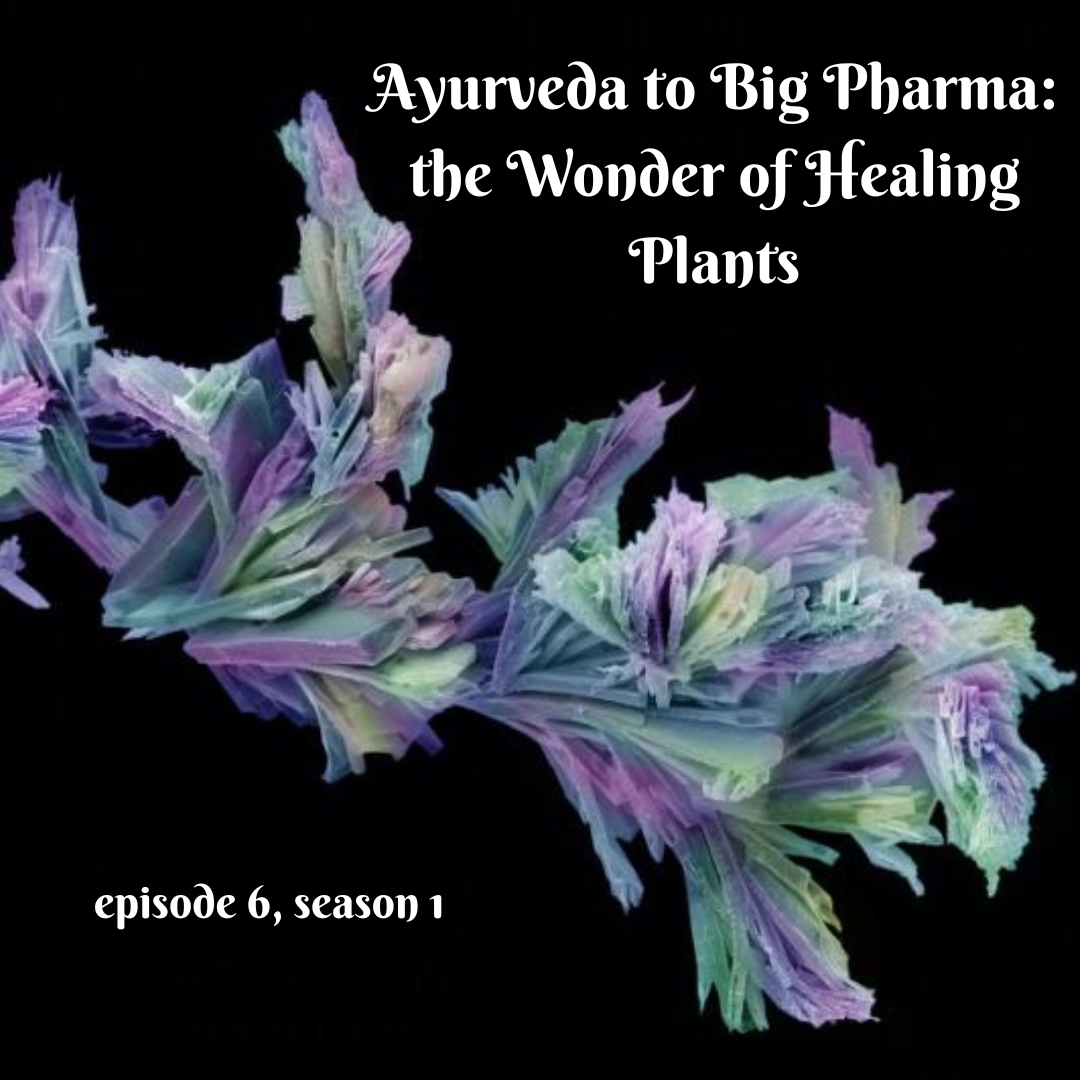Season 1, Episode 6
Ayurveda to Big Pharma: the Wonder of Healing Plants
Throughout history, plants have yielded a range of medical remedies. Neem leaves so bitter they wash the worms out of stomachs in Indus Valley cities four thousand years ago. Complex Ayurveda concoctions of spices and herbs to ward off disease. Or the pills and injections of modern pharmaceuticals, a quarter of which derive from plants.
But plants are more than medicine. They have driven exploration, empires and colonization. Europe’s insatiable demand for spices and botanical remedies creates pipelines of plunder and trade across the world. As the bedrock of the pharmaceutical industry, the transformation of plants has sometimes overthrown millennia of indigenous medical wisdom.
“Healing Plants” traces the journey of plants as medicine and commodities from ancient times to the present. As you reach for that tablet in your medicine cabinet, perhaps there are echoes of its healing properties in a makeshift book found in the desert along the Silk Road.
Time Markers
00:17 a murder in the Karakoram Pass
04:30 recipe for memory and intelligence
05:40 intro
07:39 plants as healers
12:06 plants as drivers of empire
14:22 tragic life of garcia de orta
16:29 hortus malabaricus
19:52 plants as commodities
20:58 a visit to the spice bazaar
24:53 supply trade for the green trade
26:30 agents of conquest
27:25 biochemical revolution
Image: Aspirin crystals. Annie Cavanagh via Wellcome Collection

Sign up for updates
Reading List
Chakrabarti, Pratik. “Neither of meate nor drinke, but what the Doctor alloweth”: Medicine amidst War and Commerce in Eighteenth-Century Madras. Bull Hist Med. 2006 Spring; 80(1): 1–38. doi: 10.1353/bhm.2006.0009
Freedman, Paul. Search for Flavors Influenced Our World. Yale Center for the Study of Globalization; 2003. https://yaleglobal.yale.edu/content/search-flavors-influenced-our-world. Accessed Sept. 12, 2020.
Ghanapatigal, Govind Prakash Bhat and Bhat, Satyanarayana; audio production K. Suresh. Powerful Mantra for Medicinal Healing, Oshadhaya Suktam, Yajur Veda. https://youtu.be/AE2RD07FXE0; 2020. More info at https://ghanapati.com/
Gottardi, Davide; Bukvicki, Danka; Prasad, Sahdeo, Tyagi, Amit K. Beneficial Effects of Spices in Food Preservation and Safety. Frontiers in Microbiology, Vol. 7. https://www.frontiersin.org/article/10.3389/fmicb.2016.01394. doi: 10.3389/fmicb.2016.01394
Grove, Richard. Indigenous Knowledge and the Significance of South-West India for Portuguese and Dutch Constructions of Tropical Nature. Modern Asian Studies, Vol. 30, No. 1, pp. 121-143; 1996. https://www.jstor.org/stable/312903
Indian Medicinal Plants – Fact Sheet. National Medicinal Plants Board, Ministry of AYUSH, Government of India. https://nmpb.nic.in/content/medicinal-plants-fact-sheet. Accessed Sept. 12, 2020.
Jaiswal, Yogini S. and Williams, Leonard L. A glimpse of Ayurveda – The forgotten history and principles of Indian traditional medicine. J Tradit Complement Med. 7(1): 50–53; 2016. doi: 10.1016/j.jtcme.2016.02.002
Krishnamurti, Chandrasekhar and Rao, SSC Chakra. The isolation of morphine by Serturner. Indian J Anaesth. 2016 Nov; 60(11): 861–862. doi: 10.4103/0019-5049.193696
Manilal, K.S. Medicinal Plants Described in Hortus Malabaricus, the First Indian Regional Flora Published in 1678 and Its Relevance to the People of India Today. In: Multidisciplinary Approaches in Angiosperm Systematics, Volume II, 558-565. Maiti, Gaur Gopal and Mukherjee, Sobhan Kumar, Editors. Department of Botany, University of Kalyani; 2012.
Manilal, K.S. A Study on the Role of Itty Achuden in the Compilation of Hortus Malabaricus. In: Hortus Malabaricus and the Socio-Cultural Heritage of India. Chapter 3, pp. 41-75. Indian Association for Angiosperm Taxonomy; 2012.
Pandey, VN and Pandey, A. A study of the Nāvanītaka: the Bower manuscript. Bull Indian Inst Hist Med Hyderabad. 1988; 18(1): 1-46.
Pasha, AK. Arabs and Euro-Asian maritime contacts. Journal of Historical Archaeology & Anthropological Sciences. Vol. 3 (3): 418‒429; 2018.
Prasad, Amba. Vasso da Gama and the Discovery of the Sea-route to India. Proceedings of the Indian History Congress, Vol. 37 (1976), p. 336. http://www.jstor.com/stable/44138961
Ram, H.Y. On the English edition of Van Rheede’s Hortus Malabaricus by K. S. Manilal (2003). Current Science, 89, 1672-1680; 2005.
Raman, Anantanarayanan. Plant lists from ‘olde’ Madras (1698-1703). Current Science. 2018; Vol. 115, No. 12. pp. 2336-2341.
Ravishankar, B and Shukla, V J. Indian Systems of Medicine: A Brief Profile. Afr J Tradit Complement Altern Med. 2007; 4(3): 319–337; 2007. doi: 10.4314/ajtcam.v4i3.31226
The Roxburgh Artists. http://apps.kew.org/floraindica/htm/artists.htm. Royal Botanic Gardens, Kew (2006). Accessed September 12, 2020.
Sealy, J. R. The Roxburgh Flora Indica Drawings at Kew. Kew Bulletin, Vol. 11, No. 2 (1956), pp. 297-348. http://www.jstor.com/stable/4109049
Spudich, Annamma. Such Treasure & Rich Merchandize: Indian Botanical Knowledge in 16th and 17th century European Books; in conjunction with the exhibit “Such Treasure and Rich Merchandize” at the National Centre for Biological Sciences, TIFR, Bangalore, February 2008.
VS, Kumar and V, Navaratnam. Neem (Azadirachta indica): prehistory to contemporary medicinal uses to humankind. Asian Pac J Trop Biomed. 2013; 3(7): 505-514. doi:10.1016/S2221-1691(13)60105-7
WHO global report on traditional and complementary medicine 2019. Geneva: World
Health Organization; 2019. Licence: CC BY-NC-SA 3.0 IGO.
Winterbottom, Anna. Medicine and Botany in the Making of Madras, 1680–1720. In: The East India Company and the Natural World. Damodaran, Vinita; Winterbottom, Anna; Lester, Alan. Palgrave Macmillan, 2014.